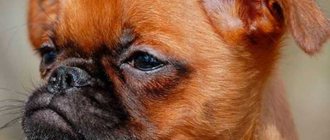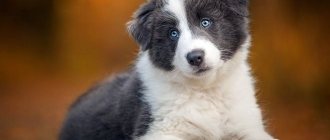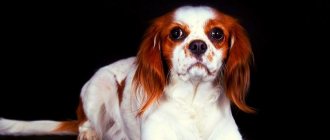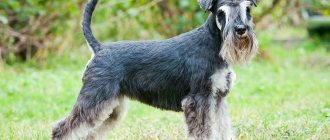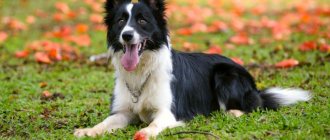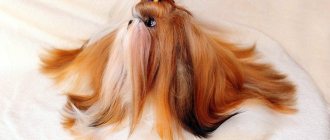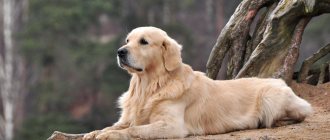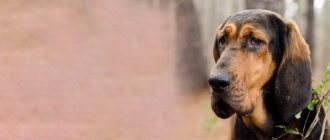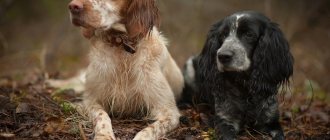Origin, what country are dachshund dogs from?
The name of the breed comes from the merger of two German words: Dachs (badger) and Hund (dog). Loosely translated into Russian, it sounds like “badger dog.” The Germans used to call this breed Dachshund, but a shortened version has taken root in the modern language: Dackel or Teckel.
The breed originated in southern Germany around the sixteenth century. At this time, the first written mentions of dachshunds appeared as “badger dogs”, “crawling after a badger” or “badger warriors”.
It may sound surprising, but the ancestors of short-legged taxis are considered to be German hounds, known as “Deutsche Bracke”. Dachshunds inherited from these light and graceful hunters the ability to pursue an animal with a voice, endurance, excellent instincts and hunting passion. Fearless and intelligent short-legged dogs reached the beast in its lair, easily climbed into any holes, and penetrated into the narrowest holes.
The hunters appreciated the special talent of the squat dog and purposefully began to breed a new breed. In those days, hunting was considered a prestigious and expensive activity, entertainment for the nobility and wealthy people. But the modest size of dachshunds, their endurance and devotion to the owner simplified and, more importantly, made it cheaper to care for a pet, which allowed the breed to gain recognition among people with average incomes - poor burghers and the petty nobility.
What types of dachshunds are there?
In the seventeenth century there were only two types:
- low, bow-legged dogs for underground hunting;
- walking hounds with coarse hair.
Both species quickly won the love of their owners and spread throughout Germany, and by the end of the eighteenth century, beyond the country. Kennels began to appear where owners bred dogs, focusing on their own desires: some focused on hunting talents, others improved their exterior.
As dachshunds spread, it became necessary to systematize the breed. A clear division into decorative and working types had already appeared, but the standard was established only in 1870. Today they use modern standards documented in 1979 in Germany.
There is a division by wool:
- short-haired (smooth-haired):
- long-haired;
- Wire-haired.
Each of these types is also divided by size:
- standard;
- dwarf;
- rabbits (toy dachshunds).
Now the division between decorative and working types has almost disappeared. In some places in Europe, these hunters are still used for their intended purpose, but in Russia, America and other countries, dachshunds are increasingly perceived as cute pets.
Short haired dachshund
The smooth-haired or short-haired dachshund is the most common type. The dense short fur shines like polished wood and emphasizes the prominent muscles. The taxi driver looks fit and “cool macho”: there are no sagging folds or flabby areas of skin.
Longhaired dachshund
This type differs from others only in the length of the pile. The Shaggy Goldfinch boasts a beautiful, shiny, slightly wavy coat. This is the legacy of one of the ancestors - the spaniel. The second “parent” of the long-haired beauty is a standard smooth-haired dachshund. Unfortunately, this type is not very common in our country.
Wirehaired dachshund
This taxi was developed relatively recently. The wire-haired dachshund differs from its fellow tribesmen not only in its “increased shaggyness.” She has a funny mustache and goatee, and her eyes are covered with rather impressive eyebrows. Outwardly, she looks a little like an Australian terrier.
Breeders needed the hard coat to protect their pets from the teeth and claws of potential prey. And the dense pile does not allow water to pass through, which is very convenient both when “forcing water obstacles” and on bad weather days. Rain, snow, frost are not scary for a shaggy dog. And it is easy to care for such wool.
Dwarf and rabbit dachshund
Breeders of the standard dachshund used its features (short legs, modest size) to create new species. Dwarf dachshunds were originally bred to improve the breed's hunting capabilities. The smaller the dog, the more sneaky it is. And the fighting character and endurance make us treat every representative of this breed with respect, despite their size.
The ancestors of the rabbit dachshund were also representatives of the medium or small breed of German “badger warriors”. The toy dachshund is the smallest of the dachshunds. It was bred specifically for hunting rabbits, hence the name of the species. At first, the tiny dog was really only a hunter, but the touching dog quickly won the affection of lovers of “pocket” pets. And now the rabbit dachshund is usually perceived as a decorative, sofa dog.
Why do dachshunds sleep on their backs?
When a dog lies on its back, all its muscles are relaxed. This is the most comfortable sleeping position. However, it is also the most dangerous from the point of view of wild animals. In the natural environment, in this position, the most unprotected parts of the body remain vulnerable: the throat, stomach and chest. If a dog sleeps in this position, it feels comfortable. This applies to both physical and psychological state. If there is pain in the spine, the animal will prefer to sleep on its side. If the pet senses danger or sees a potential threat nearby, it will not be able to be in such an open position.
Many owners believe that sleeping on their back can be dangerous for their dog's spine. In reality this is not the case. Only those animals that already have diseases experience discomfort. Healthy companions are not in danger. Problems can only arise if the animal sleeps on an uneven surface. For example, the head and chest are on a thick, large pillow, and the rest hangs down.
You should be wary if your dachshund snores when sleeping on its back: this may indicate breathing problems.
Arranging a comfortable place to sleep can prevent injuries and the development of pathologies. In general, the general rules should be followed. The animal should not sleep near the radiator or in a draft. It is allowed to use rugs, mattresses, houses, beds with sides, etc. The type of design depends on the preferences of the pet. Some dogs like to watch what's going on, so mattresses are better for them. Other animals prefer houses because they feel safe in them. The size of the sleeping place should correspond to the dimensions of the companion. It is advisable to have a reserve so that the dachshund is not crowded. Representatives of this breed love warmth, so you can offer the dog a blanket.
What colors do dachshunds come in?
It is a mistake to think that these dogs are only brown or black. Dachshund coat color can be:
- single-color (from yellow to dark red);
- two-tone (black or deep brown accentuated with light gray tan marks);
- spotted (the pattern resembles marble tints or tiger coloring).
Varieties of one-color color:
- completely black (small markings are visible only in good lighting);
- completely white (the nose can be black, brown and even pink);
- red (from golden to red-red, but all the fur is the same color).
There are quite unusual colors:
- cream (very light red);
- blue (from silver-steel to graphite black);
- gray (same shades as the previous one, but no bluish tint);
For wire-haired beauties, not only the listed options are relevant, but also more complex shades:
- boar color (alternating brown stripes from silver-gray to almost black);
- color of dry leaves (all shades of brown from light sand to dark chocolate).
This is not entirely fair, but for smooth-haired and long-haired boar species, color is considered a defect in the breed. And this is the only exception. Otherwise, the standard does not distinguish between different types of dachshunds. Any taxi, regardless of size, is considered purebred if the color of its coat falls within the designated framework.
On the edge of the bed
Further than at the feet - on the very edge of the bed - representatives of large or fighting breeds of dogs most often sleep. Such pets always keep everything under control and consider it their duty to protect their owner, especially when he is sleeping. This is a faithful guard who is always on the alert, he is ready not only to warn you of danger, but also to actively protect you. The dog also chooses this place because it is quite large, and it is simply hot in blankets and pillows.
Characteristics and description of the breed
In Russia, the dachshund has long been viewed more as an amusing pet than as a hardy hunter. Among the lovers of these dogs was Anton Pavlovich Chekhov, who described his “living creatures” this way: “I have news: two dachshunds - Brom and Hina, ugly-looking dogs. The legs are crooked, the bodies are long, but the mind is extraordinary.”
Napoleon, Picasso, the great Russian actress Ermolova, American artist Andy Warhol and other “stars” valued dachshunds for their intelligence and fighting qualities. And the explorer of the underwater depths, Jacques-Yves Cousteau, always took two taxi drivers on expeditions, whose names were Bull and Spacesuit. Today's representatives of the elite also easily succumb to the charm of bandy-legged smart girls.
Adult dog size and weight
A breed standard is a verbal description of an ideal dog. It includes both external parameters (exterior) and characteristic features of behavior, temperament, and working signs. Each country has its own standards, which may differ slightly in detail, but the main features always remain the same.
Table of parameters of various types of dachshunds.
| Species name | Height, cm | Weight, kg | Chest volume, cm | |
| boys | girls | |||
| Standard fee | 22-27 | 20-25 | 6-9 | 35 and more |
| Dwarf | 16-21 | 14-19 | until 6 | 30-35 |
| Rabbit | 12-15 | 10-13 | until 3 | no more than 30 |
An ordinary purebred adult dachshund (12-15 months) can reach a weight of 14 kg. The height of dogs is not regulated, on average they grow up to 22 cm. Small deviations are possible (up to 25-27 cm), but these parameters are within the norm.
Character
It’s quite difficult to call a dachshund a cute creature, but its long, straight back and proud head carriage involuntarily evoke respect. And the impression is not spoiled even by the wayward and stubborn character of the dog. These loyal companions and reliable guards always have their own opinions and are difficult to train.
They get along well with children, are ready to protect their owner in any situation, and love to relax in their owner’s bed. But the dachshund cannot be blamed for the latter - for centuries this breed has been trained to sleep in the same bed with a person in order to guard his sleep, protect him from rats and keep him warm on long winter nights.
Taxi drivers claim that long-haired dogs are calmer, while dogs with coarse hair are the most sociable and playful. There is no evidence of this, but the versatility of pets is revealed depending on the character and habits of the owner. With a hunter, the dachshund will be a tireless pursuer; with an artist, it will be a source of inspiration. A small dog will help politicians and leaders find balance before a difficult day. And everyone, without exception, will be flooded by an ocean of canine joy from meeting their beloved owner.
Dachshund girls
Differences in character are almost independent of the gender of the dog. Girls are a little calmer, but you need to take into account regular estrus and the need for mating. Young ladies are easier to train and more flexible. Usually girls are raised by families with children and stay-at-home owners.
Dachshund boys (males)
The dachshund boy likes to turn on “male mode.” Often this smart and assertive animal becomes the master of the situation. Overcoming a dog's stubbornness and forcing him to respect his owner is not an easy task. At the same time, male dogs are quite lazy and simple-minded. These are ideal companions for strong and active owners.
Behavior and habits
The dogs are very clean. If there is a lack of care, they can become seriously offended by their owner and even get sick. Curious and restless dachshunds often play pranks, but this is more a problem for the owners than for the little hunters. The dog will happily burrow into a heap of fallen leaves (and collect all the garbage), explore the depths of such a tempting puddle, stick his nose into some crevice, and so on. You shouldn't blame the dog for this. The breed was originally bred precisely for such actions: to find an animal, explore a hole, and capture prey. If the owner gives free rein to his pet during a walk, then at home the dog will not be too mischievous.
Aggression is not typical of these charming dogs. However, during illness (for example, when changing teeth), the animal can snap and even bite the owner. Stress, lack of attention and affection can also cause negative emotions. A very simple cure can save you from this: affection, attention, proper care and education.
Dachshunds are not born aggressive. Any negativity is the result of the actions of the owners or a painful condition.
Dachshund intelligence
Reason and independence were initially needed by the hunter to survive. When the dog climbed into the hole with the beast, he could only rely on his own strength and intelligence. Stupid or indecisive individuals simply did not survive in such conditions. Natural selection has led to the emergence of a breed with mental abilities that can be envied.
Security qualities
The ability to quickly navigate a situation, make the right decisions or defend one’s opinion helps the dachshund to perform excellent security and hunting functions. But the owners will have a hard time - finding a common language with a smart dog is possible only on the basis of mutual respect.
The dark side of the dachshund: 6 negative qualities
Since I am a chronic taxi lover, any shortcomings of these dogs seem to me to be just cute features. But if you haven’t been struck by taxomania yet, pay attention to them to think about the consequences before your first dachshund.
Megalomania
Any dachshund, even a tiny one, will more than once think about the question - is it not the main one in this house? In order for this impudent long-nosed dog to follow your orders, you will have to train from the very first days. And then spend your whole life proving that the owner is the main source of food, pleasure and entertainment. And that you are able to overrule a dachshund, even if you don’t have time/too lazy/you’re very tired/it’s possible just once. If you give in, your opinion will no longer be taken into account when making decisions.
Willfulness, stubbornness and a tendency to dominate make the dachshund not a suitable dog for older people or those new to dog ownership. Owners who cannot put a dachshund in its place create a despot and a monster with their own hands.
Loud voice
It was very important for hunters to hear the dachshund’s voice while in a deep hole. Therefore, we can say that loudly barking animals have been selected for generations. On the one hand, this is a plus - by the voice behind a closed door, a dachshund can be confused with a large and menacing dog. And intruders will be careful not to enter. On the other hand, if the pet is not raised properly, the dachshund can turn into an empty dog.
A separate problem arises if the dachshund howls and barks when left alone. Deprived of work, the dogs receive neither physical nor mental stress. This causes various behavioral disorders, including howling. Hello neighbors.
Do not leave me alone
Tendency to bite
Many people consider dachshunds to be aggressive. But this is not entirely true. They just don’t have any “moral barrier” to harming a person. Dachshunds often bite their own owners and family members - if they consider themselves to be the leader. Then a person will be bitten if he tries to push the boss off the couch, take away food, or clean the pet’s ears.
The second reason for biting is if the dachshund is defending itself and is afraid. Hitting a dog while training or in the heat of the moment is unacceptable. This will not end well, especially since dachshunds have excellent memories. A dog may attack a certain smell, for example, someone who has been drinking.
The third reason is territorial aggression. When I first brought the dachshund to the dacha, it bit my neighbor’s leg until it bled. She didn’t bark, she just came up and snatched him from behind on the sly. This happened when an elderly lady came to our house. The dog had not seen it before and decided that it was a stranger. But that didn’t make it any easier to explain to the bitten woman! The dachshund would also bite the neighbor's children if they ran around our site squealing and making noise.
Sharp teeth and strong jaws - dachshunds bite very painfully
Zoo aggression
A dachshund can get along well with cats in the house - and selflessly chase unfamiliar cats on the street. They need to realize the hunting instinct, they want to chase the beast. The smell of rodents seizes them especially madly. How many times have I seen sobbing owners who decided that nothing threatened the hamster in the cage. In the village, a dachshund can choke rabbits or chickens, so the pet should not be allowed to roam on its own.
Contrary to fears, dachshunds easily get along with cats in the same house
Cats are warm and soft, you can lie down on them to sleep
If you take a dachshund with an adult cat as a puppy, they will become friends for life
Without timely socialization, dachshunds have difficulty communicating with relatives, especially those larger than themselves. More than once I have watched a tiny “sausage” clack its teeth a centimeter from the muzzle of a perplexed Labrador or Shepherd. All that remains is to recommend keeping the dachshund on a leash, because courage will not help it avoid injury when fighting with a dog several times larger than itself.
It’s good if a dachshund meets other dogs while walking
Gluttony
When a dachshund is awake, it is in one of two states: looking for food or eating. Dachshunds are masters at begging, their pleading gaze breaks through the most persistent. I have never seen a dachshund so full that it would refuse a tasty morsel.
On the one hand, a food dog is not bad, because it greatly simplifies training. On the other hand, for most of the walk you will be making sure that your pet does not vacuum up anything from the ground.
You yourself are fat!
Dachshunds not only beg, but also steal. My bad girl once chewed through a bag of food that I carelessly left in the hallway. The dog resembled a globe, but had no intention of dying.
If you take a puppy into your home, you will have to get used to order. You need to hide not only food, but also all potentially dangerous objects: dachshunds may consider something that you wouldn’t think of as edible - lipstick, cream, a used diaper.
I am starving. I'm already fainting!
Destructive tendencies
For such a small dog, the dachshund has surprisingly powerful jaws. And paws. And claws. In a word, you can’t let such a pet get bored, or your apartment will end up with designer renovations. It’s easy to dig up a sofa while playing hole. It’s easy to peel off the wallpaper. Grind everything left unattended - why not? At a summer cottage, a dachshund can destroy the lawn by digging holes in it.
Dachshunds handle toys from the pet store in a matter of minutes, and only treats like reindeer antlers or rubber balls can keep them occupied for a long time.
What?
You're back too early!
What does “this is your rubber band” mean? I took it first!
Author's comic about the antics of a dachshund (opens in a new tab)
What does a dachshund look like?
The modest size of the dachshund sometimes suggests the fragility of its body. In reality, it is a strong creature with a strong skeleton and well-developed muscles. Short, crooked legs and a low center of gravity allow the dog to stand firmly on the ground, and its voluminous chest allows it to develop high speed.
Dachshund head and teeth
An elongated muzzle with a long nose is needed by a hunter to scout an animal's hole. From above, the skull resembles a cone rounded towards the top, the profile smoothly tapers towards the nose. The transition from forehead to muzzle is also smooth, without a sharp border. The lips are pulled tight and completely cover the lower jaw. The teeth and jaw bones are strong, like those of any hunter. The mouth can open wide.
Eyes and ears
The long soft ears are set quite high, very mobile and have a rounded shape. However, this is not only decoration. Yes, they are pleasant to cuddle and stroke, but hunting dogs need long ears for a completely utilitarian purpose - it is better to “feel” the smell of prey. The nose catches the smell remaining in the air, and the long ears, touching the ground, raise small particles and dust, intensifying the smell and creating ideal conditions for the nose to work.
The medium-sized almond-shaped eyes are slightly askew, which does not spoil the impression at all. Massive brow ridges add seriousness to the dog’s appearance, and sparks of fun jump like small demons in the depths of his beautiful brown eyes.
Dachshund nose
The small hump of the nose ends in a soft black or dark brown lobe. Movable nostrils help determine the direction of the smell. When healthy, the nose should be moist and cool. This sensitive detector is equipped with 125 million olfactory receptors (humans have a modest 5 million at best).
Dog's neck and body
The dog's elongated, muscular body creates a strong support for the voluminous chest and high neck. The chest is clearly defined and equipped with a characteristic “keel”. The dachshund has 7 cervical, 13 thoracic, 7 lumbar and 3 sacral vertebrae. Intervertebral discs, elastic in youth, create an excellent buffer and act as shock absorbers.
The scruff and neck are the area where many muscles, tendons and ligaments converge, on which forward movement depends. A long neck means long muscles, greater freedom of movement and quick reactions. In addition, when the dog moves, the elongated neck is always slightly tilted forward, which shifts the center of gravity and forces the legs to “catch up” with the head. This way the pet increases speed without putting excessive strain on the muscles.
Limbs and tail
Plump and short paws are often slightly crooked, with well-developed muscles. The front legs are slightly more massive (wider and larger) than the hind legs. The strong shoulder of the forelimbs goes into a short powerful forearm. When positioned correctly, the forearm should be slightly tilted inward and seem to support the chest. The long and strong thighs end in a short tibia, attached to them at a right angle. The strong tail, thick at the base, is usually extended just below the line of the back, and in an excited state it turns into a vertical “antenna”.
Dachshund paws
The tightly clenched toes end in strong, evenly spread claws. With this “rake”, a dachshund can dig a hole more than 40 cm deep in a minute. Thick and hard finger pads are not afraid of cold or small debris. The front legs may be straight or slightly turned outward. The rear ones are slightly smaller in size and width. A standing dog distributes its body weight evenly across all four limbs.
Briefly about the breed
The Dachshund is a short-legged, muscular and squat dog whose size is based on proportions. Thus, the body length of a thoroughbred animal should be 1.7 to 1 to its height, and the distance from the bottom of the chest to the support should be 1/3 of the height.
Different types of breeds, long bred for hunting animals of different sizes, have their own dimensions:The standard type of dog is the largest and most versatile, used for burrow hunting and chasing large animals. Its dimensions are characterized by a height of about 35 cm, a sternum girth of more than 30 cm and a weight of up to 9 kg.
Miniature or dwarf dachshunds occupy a middle position, with a height and rib girth of up to 35 cm, and a weight of 3 to 4 kg. Dwarfs were bred from the stockiest animals of the standard species.
The shortest among the dachshunds is called the rabbit dachshund and is 5 cm shorter than its average counterpart in height and 1 kg less in weight.To obtain a more compact and nimble hound, the dog was crossed with pinschers and toy terriers and used in hunting hares and rabbits.
The standards also spell out body features: a wedge-shaped head, a flat, wide forehead and a flattened nose, oval eyes of dark brown and lightened shades, ears broken in the lower third, a long neck and a saber-shaped low tail.
Dachshund care and maintenance
You can start bathing your pet with detergents “from a young age,” but not more than once every 3-4 months. Baby shampoo or special products for dogs will do. Rinse aid and conditioner should not be used. At the same time, you can rinse the baby dachshund in clean water, without soap and shampoo, at least every day.
Grooming
For short-haired dogs, it is enough to dry them with a terry towel and then brush them with a medium-hard brush. Long-haired beauties require daily combing with a wide-tooth comb. Wire-haired pets can only be brushed once a week with a brush or comb. They don't need a haircut.
Nail care
Adult dogs do not need to have their nails trimmed. They should wear out naturally: during long walks on the street with asphalt or other hard surfaces. If this condition is not met, a haircut will be needed (once every 3 months). Puppies have their nails trimmed every two weeks by about a couple of millimeters.
Dental care
With proper feeding, the dachshund has virtually no problems with its teeth. If plaque does appear, you need to start brushing her teeth regularly with a special paste. Any diseases of the gums or teeth cannot be treated on your own; you need the help of a veterinarian.
Feeding your pet
To choose the right food, you should ask the breeder what he fed the entire litter. There are a couple of conditions that will make caring for your dog easier:
- mixing natural products with dry food is dangerous;
- It is advisable to transfer to another type of feeding under the supervision of a veterinarian.
A one-month-old puppy receives mother's milk or a special mixture (egg with goat's or cow's milk). Later, the child can be given cottage cheese, meat, vegetables, kefir, and porridge. Starting from 4 months, raw meat (lean) is gradually introduced into the diet.
Adult dogs thrive on ready-made food. Mixtures labeled “for medium and small breeds” or special foods are suitable for them. Food designed for large species should not be given to your pet: it contains too many calories. Gluttonous dogs are unable to refuse delicious food and quickly become obese. And a full dachshund is always a sick and sad dog.
The optimal amount of food for a dachshund is 40 g per kilogram of live weight.
Toilet training
You need to start litter box training from the very first minute your dog is in the house. The metabolism of puppies is very intense. The dog cannot wait until the next walk, so a tray is necessary. When a new pet first comes into the house, it should be immediately placed in a pre-prepared place (box, basket, lined with a diaper). You can let him roam freely only after the child relieves himself in this place. And every such “feat” is necessarily rewarded with affection and something tasty.
Training and education of a puppy and an adult dog
Raising a puppy will have to start with raising the owner. Before you bring a tiny pet into your home, you will have to take care of a lot of things:
- remove or block access to all electrical wires;
- prepare bowls, food, a place to sleep, a toilet;
- hide all shoes in an inaccessible place (and maintain this order);
- Explain to children how to handle a “living toy”;
- place indoor plants that are poisonous to dogs (ivy, carnations, poinsettia) as high as possible;
- do the same with cat bowls (if there is a cat living in the house);
- block access to bottles with household chemicals.
First, the dachshund is taught basic commands (“Come to me”, “No”, “Sit”, “Place”, etc.). Each command needs to be practiced: slightly pull the pet on a leash with the command “Come to me”, gently press on the lower back with the command “Sit”, etc. Correct execution must be reinforced with a tasty piece and stroking.
Walk
The more often you let your baby dachshund outside, the friendlier and more sociable the pet will grow up. Ideal walking pattern:
- early in the morning, immediately after getting up;
- 20 minutes after eating (preferably after each feeding);
- in the evening before bed.
For an adult dog, 2-3 walks a day, lasting at least half an hour, are necessary. You need to walk your dog on a leash with a harness, and not with the usual collar. The harness covers the dog's body and redistributes the load over the entire body area. The collar reduces all jerks or tension to one area, increasing the risk of damage to the cervical vertebrae.
Mating, pregnancy and childbirth of a dachshund dog
It is advisable to carry out the first mating at the age of 15-20 months, when the girl has already had two or three heats. Sending a young lady on a date with a gentleman at a younger age is dangerous to health: early pregnancy and childbirth are difficult and can have dire consequences.
The first signs of pregnancy are expressed in a change in the dog's behavior. She becomes more gentle, calmer, and at times seems unhealthy. The normal duration of pregnancy is 60-63 days. Viable puppies are born between 53 and 71 days after mating. Dachshunds can suffer from toxicosis. This unpleasant condition occurs at the end of the first month of pregnancy.
The owner will have to feed the expectant mother with special formulas for pregnant women or increase the content of protein products in the diet.
Precautionary measures
If your dog sleeps with you, there are some precautions you need to take:
- Your pet must be vaccinated and treated against parasites.
- After each walk (especially in the evening), thoroughly (with tar soap) wash your pet’s paws, belly, and butt. It is not necessary to wash the body with soap every time; simply wipe it with a damp palm.
- From time to time, check your pet for fleas and skin infections that can be dangerous to humans (lichen, fungus). If something is wrong, you will immediately notice changes in the skin and coat (redness, hair coming out, etc.).
- Be sure to maintain hygiene. Clean your animal's teeth, ears, and trim its nails.
- Do wet cleaning of the room where you sleep more often.
- Ventilate your bedroom before going to bed.
Well, if you still can’t get enough sleep when your dog sleeps with you, then you need to come to some kind of compromise.
Predisposition to disease, life expectancy of dachshunds
A happy and healthy dachshund can live 12-16 years. Contrary to popular belief, short legs do not interfere with running. The animal's spine experiences a much greater load. Improper training and excessive nutrition provoke problems with intervertebral discs (wear, displacement, hernia). In the most advanced cases, even paralysis is possible.
Loads dangerous for a short-legged pet:
- running too fast;
- jumping over obstacles;
- tug of war;
- other actions that overload the spine.
The owner should not suddenly pick up the dog or squeeze it too hard or roughly. Your pet needs a ramp to get up. Even slowly climbing stairs is dangerous; it causes severe pressure on the spine. To understand how difficult it is for a short-legged friend, the owner can try to climb an obstacle higher than his own height.
Long touching ears can cause dogs a lot of trouble. The soft ear blocks the ear canal, creating a moist and warm environment inside - ideal conditions for pathogenic microflora and the development of otitis media. The owner must ensure that no water gets into the ear canal and regularly inspect and clean the pet’s ears.
In their normal state, taxis are playful and cheerful creatures, but a sedentary, overfed dog is capable of displaying aggression. We must not forget that these are hard workers by nature. They need movement, and the more the better. Lack of physical activity leads to irritability and sometimes outright aggression. And this is not a manifestation of the pet’s bad character. In most cases, the situation changes as soon as the dog gets the opportunity to redirect emotions into physical activity.
An hour-long walk in the morning and evening saves you from “bad character” better than any medicine.
Weaning methods
Before you tell your dog where he should sleep at night, you need to take him for a walk. It is important that the pet spends more energy, then the dog will have less resistance when laying down in a new place. You can lure the dog with its favorite treat, and praise it if it lies down on the bed.
It is not recommended to forcefully drag the dog to the bed or pick it up and lay it down. In the future, this may cause a sharply negative attitude towards the sleeping place and all kinds of resistance.
It’s easier to sleep-train a dog that understands commands. The main command given by the owner clearly and clearly is “Place!” After executing the command, it is important to praise the pet or give it a reward. If the dog tries to leave the bed, you must clearly pronounce the command “No!” and take the pet to its place. Over time and regular training, the dog will begin to understand where its private place is.
Mixed dachshunds
Metis is the result of crossing a taxi dog with other breeds, most often with a terrier or chihuahua. In everyday life and communication, such half-breeds are no worse than purebred animals. Character depends only on hereditary factors and upbringing - all claims are against mom and dad and the owner.
Whether the inability to take part in exhibitions should be considered a disadvantage of a mixed breed is a controversial issue. If the owner has chosen a touching and funny mixed breed, it is unlikely that he is going to take prizes at purebred dog competitions.
The advantages of half-breeds are their relatively low cost and resistance to disease.
Alarm clock dog
When your pet falls asleep next to you unnoticed, but in the morning brings his wet leather nose to your face to wake you up, this means that he is very playful. Such animals do not like to sit still, they are very active and always on the alert. In addition, a four-legged dog with such a character will always protect its owner, as it loves him immensely.
If there is little snow, there will be no harvest: December 16 is Ivan the Silent Day
Women's jeans: before you buy them, you need to pay attention to one detail
Smooth and fresh skin: dermaplaning, or why a woman needs to shave her face
Suitable nicknames for dachshunds
Choosing a name is a big decision. There are important and formidable options, there are funny nicknames or complex compound names. However, a long, tricky nickname sooner or later in everyday life turns into a short “household” nickname: Bunny, Musya, Mila.
It’s more convenient to immediately give the taxi driver a short name, for example:
- serious “growling” Archie, Harry, Robert, Merlin;
- affectionate Knopa, Rose, Eddie;
- funny Busya, Cactus, Hot dog.
Girls often receive the nicknames Martha, Shelly, Ursula, Fiona (especially after the release of the popular cartoon about Shrek). Boys are sometimes given pretentious names: Count, Lear, Caesar, Oscar.
How to choose a dachshund puppy
Sometimes a dachshund is chosen “for its beautiful eyes.” Yes, it’s not easy to resist this touching creature, but you need to take into account the health and pedigree of the puppy, make sure there are no hereditary diseases, and look at the living conditions of the mother and litter. If the breeder is in no hurry to show the buyer the documents or the mother’s living conditions, you should not agree to the purchase.
Pay attention when choosing a puppy:
- dachshund activity;
- good coordination of movements;
- absence of an overly bloated tummy (even after feeding);
- smooth, shiny coat;
- eyes do not water, there is no frequent blinking;
- flat back without hump or deflection;
- a scar on the hind legs from the removal of the fifth “dewclaw” toe (the operation is performed on the second day of the puppy’s life).
It is better to start your search by asking the breeder about the character and behavior of the pet. An experienced dog breeder will help you choose a pet that matches the owner.
In Russia there is a public canine organization, the National Dachshund Breed Club, which regularly holds exhibitions and monitors the preservation of breed standards. Complete, and most importantly, reliable information about dachshunds, all details on care, training and treatment, recommendations for choosing a puppy can be found on our website.
Really, how long do dogs sleep?
I never asked myself this question, but I began to monitor my flock and look for information.
With such active children, any minute of calm = sleep. It turns out that the norm for dogs is 12-14 hours. However, it varies greatly depending on the dog's size, lifestyle, breed and health.
Active, lively dogs like huskies sleep less than couch pugs, for example. But after exercise, intensive training, harness work, and so on, active dogs will surpass anyone in the amount of sleep)))
There’s a special thrill in the crib
Mine seem to be constantly sleeping! Well, or they run. It seems that they have only two stages: super-active and super-calm))) But this is only at first glance. When I began to monitor my dogs more closely, I ended up with -14 hours of sleep, which is the norm.
Puppies sleep longer - up to 20 hours, and also old dogs, dogs with diseases, with metabolic disorders. Found a sleeping person - lie down next to him
Where to buy, prices in nurseries and “from hand”
It’s hardly worth reminding that purchasing a purebred dog “from your own hands” is risky. Even if the purity of the breed is not important, there is a risk of getting a sick animal. It is much safer to purchase a real purebred dog from a kennel where young dachshunds receive proper care and education.
Prices for private taxis are usually very low, from 2-3 thousand. There are offers even cheaper, or even “I’ll give it to good hands for free.” Kennels offer puppies at an average price of 25-30 thousand rubles. The amount depends on the pedigree, titles and awards of the parents. A purebred dog from a breeder who is passionate about his work cannot cost a penny.
The appearance of a puppy in the house
A small puppy brought into a new home will of course whine and miss its mother. To smooth out this feeling a little, you can put a piece of fur in his bed , in which he can burrow.
Education can be postponed until later ; there is no need to grab the puppy or talk too loudly near it. It is better to sit on the floor and wait until the dog approaches people on its own.
It will be better if one of the family members can spend a couple of weeks at home with the puppy so that he is not left alone. If the dachshund whines at night, you need to carefully pick it up, holding it under the lower paws and press it to yourself, warming it with body heat.
Pros and cons of dachshunds
Cunning and stubbornness in character go hand in hand with independence and high intelligence. Independence of character leads to the fact that dogs may refuse to follow commands. Dogs understand perfectly well what is expected of them, but they do not always follow the orders of their owner: they do not consider it necessary or simply do not want to.
Smart dachshunds learn the meaning of commands the first time. Unfortunately, this does not make life easier for the owners. The innate independence of these hunters and the ability to make decisions leads to manifestations of stubbornness and cunning. Taxi drivers will try to achieve what they want by any means.
The dog does not always consider punishment for pranks to be fair. And often this is justified: if the beloved owner had walked the pet longer or paid more attention to it, the dog would not have to chew on his slippers or push his tie under the bed.
Who is suitable for a dachshund and who is not?
In short: Dachshunds are suitable for active people with a strong character. Workaholics and homebodies should not have them. The first rule for keeping even the smallest dachshunds is high physical activity. If the owner cannot or does not want to walk with the pet at least a couple of hours a day, it is better to choose a dog of a different breed.
A long, elongated body provokes problems with the spine. Stairs and high steps are dangerous for taxis. If the future owner is unable to eliminate these threats, it is not worth choosing such a breed. In addition, they should be prohibited from climbing onto furniture or other high obstacles. And the main danger for the animal is heavy weight. If the owner is unable to resist the pleading eyes of the little glutton, health problems will soon appear.
The dachshund should not be considered as a pocket dog, a funny companion or an interior decoration. This is an intelligent and willful hunter who needs training and long walks.
Walks
It's time to remember that the limousine dog belongs to the hunters. This means that the walks will not be calm: rushing headlong behind fluttering ears and wildly flickering paws, try not to teach your pet to respond to obscene words. In addition to the ears and paws, the kit includes a spout that penetrates sand and snow with equal ease.
It's funny to watch how a dachshund carefully plunges its nose into the snow, freezes, raises its head, snorts noisily and continues its search elsewhere. Then he suddenly begins to actively dig, imagining that a delicious fox is hiding somewhere very close. I think that dachshunds can serve the national economy for digging trenches and pits.
